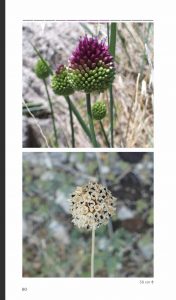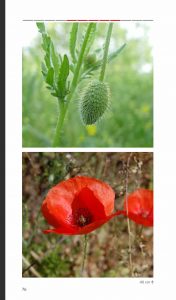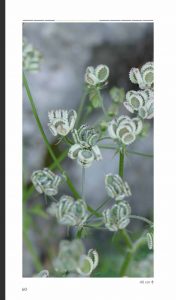Guided by the desire to help every visitor of the Klis Fortress to awaken the child-like curiosity for the colourful wildlife that surrounds us, Vedran Šegota and Ivan Limić have prepared a book that immediately transforms readers into true botanists, well-equipped to recognize the rare examples of “sea” and “mountain” flora and discover the mystery that is ascribed to them.
Convinced that both local and foreign visitors can enjoy Klis, aside from the sunshine, parties and cocktails, while looking for new, innovative content, Vedran Šegota and Ivan Limić offer readers a close encounter with the plants the visitors to the Klis Fortress don’t know much about and which surround them everywhere they go.

- Klis has recently been declared one of the most interesting destinations in Croatia that unite the history of Uskoks (a term used for a type of Croatian militiamen) and The Game of Thrones. You have now added another interesting dimension thanks to the book you devoted to plant species. What do nature lovers need to know about this place?
The Klis Fortress was built in the early Middle Ages on the inaccessible rock in the gap between the two mountains, Mosor and Kozjak, where for centuries, it had exceptional strategic importance for the defence of the city of Split and Central Dalmatia. Due to this specific position between the sea and the mainland, the fortress “hides” an extremely abundant and interesting flora with numerous endemic species. In this place, we can encounter the typical Mediterranean plants as well as the plants usually found in high mountains. By observing the plants that surround them, the Fortress’ visitors, at one point, will be under the impression that they are sitting on a beach, while the plants growing in other corners of the fortress are bringing to them the fresh mountain air. The idea behind the book ‘The Plants of the Klis Fortress’ was to bring this cultural and historical monument closer to nature lovers and thus expand the Fortress’ tourist offer. I personally come from the town of Senj, while the book’s co-author, Ivan Limić from the Uskok town of Klis, so this book is, in a way, a link between the two towns that share a common history.

- How much time did you need to investigate the flora of the fortress and the town of Klis, as well as document the existence of such plant diversity?
We researched the Fortress’ flora for a whole year in order to make sure that we covered every single species. Namely, some plants grow only at certain times of the year, and we wanted to “capture” them in all their stages, from leafing and flowering to the emergence of fruits and seeds. Ivan Limić, the co-author of this publication, contributed most to the research by tirelessly collecting the plants and bringing them to the Herbarium Collection of the Botanical Institute in Zagreb, which I am curating. There, we determined the plant species, wrote the text and selected the photos for the book. We found more than 300 plant species on the Fortress and the rocks surrounding it. In the book, we presented the 92 most interesting ones. We particularly highlighted endemic species, which grow only along the eastern coast of the Adriatic or, for instance, only in Central Dalmatia. These species will probably be most appealing to foreign readers because they cannot be found in other parts of Europe. For example, in the book, we presented Adriatic Fibigia and tiny-sepaled toadflax, the two species that were discovered in the 19th century in the Klis region.


- Does your book cater more to experts or the people who are just interested in rare plant species but have no extensive knowledge about them? Is the book good material for tourists to us?
The book is primarily written for the visitors of the Klis Fortress, who don’t need to have any previous botanical knowledge. The combination of short texts and photography for each species ensures that every reader can easily find and recognize different types of plants just by walking through the fort. We have also included the information on the size and time of flowering of these plants. This is not just a botanist’s book; it is actually written to help tourists to awaken the child-like curiosity for the colourful wildlife that surrounds us. It is important to mention that most of the species described in the book are growing along the entire Adriatic coast and on the islands, so the book can also be used as a guide on the journey through Dalmatia.
- What can plants tell us about the traditions of Dalmatia, particularly when used for cooking, in medical purposes and even in terms of the beliefs of that time?
Throughout history, people have been exceptionally connected to the plant life that surrounds them but unfortunately, such knowledge is rapidly disappearing in today’s day and age. In this book, we wanted to preserve at least one small part of that ethnobotanical wealth. That is why we particularly highlight the plants that are still used today in Dalmatia and the Mediterranean, such as figs, almonds, olives and asparagus. There is also information about aromatic and healing plants such as sage, field marigold, curry plant and St. John’s-wort. The readers can also find out after which plant the city of Split was named, which tree was used to build Noah’s Ark, which plant grows only in places that were struck by lightning, and which ones have aphrodisiac properties. Perhaps the most interesting story is the one about the endemic Dalmatian pyrethrum, which was used as a natural insecticide, which is the reason why its cultivation and export in the first half of the 20th century was one of the most important economic activities in Dalmatia. This suddenly ended with the invention of synthetic insecticides. Maguey is today a symbol of the Mediterranean, but many people do not know that it is native to Mexico and came to Europe only after the discovery of the New World. It takes up to 15 years for this plant to flourish, and right after it bears the first flowers, this plant dies. Its fibres are traditionally used on some Adriatic islands to make lace. Ancient Balkan beliefs say that hawthorn is an effective means of fighting vampires. I’ll leave it to the readers to discover other interesting stories in the book by themselves.
- How important is your book for studying Croatia’s plant abundance and is the book available to readers in other languages?
In terms of plant abundance, Croatia ranks 3rd in Europe, just after Albania and Slovenia, and bosts over 5,500 species growing on its territory. Every research of flora, including this one, represents a significant contribution to our knowledge of Croatia’s biodiversity and beyond. In order to bring this abundance closer to as many readers as possible, the book was written in five languages – Croatian, English, German, Italian and French, and, hopefully, it was made accessible to the majority of tourists on the Adriatic.

- A great number of translators and proofreaders worked on the book. How difficult is it to write and proof check such book? Was it easy to find a publisher for such a demanding endeavour?
A total of nine translators and proofreaders worked on the book. This was the most demanding segment of the entire process because we had to harmonize professional terminology in different languages. But we have been fortunate enough to cooperate with patient translators and excellent proofreaders who, apart from being native speakers, are also botanists. The book has been reviewed by several university professors and can be found in the specialized library of the Croatian Botanical Society, which is a validation of the book’s high quality. We found the publisher rather easy because the local community (the Klis Municipality) has shown great interest and has supported us during all stages of the book’s creation.
7. After Klis and the revelation of its secrets, what’s next for you?
I have many ideas for presenting another tourist destination in Croatia, perhaps in a similar manner. Apart from the sunshine, parties and cocktails, I am confident that an increasing number of tourists are looking for new, innovative content. As plants surround us wherever we go, I would like to develop the idea of man’s return to nature, even if it happens only on holiday.